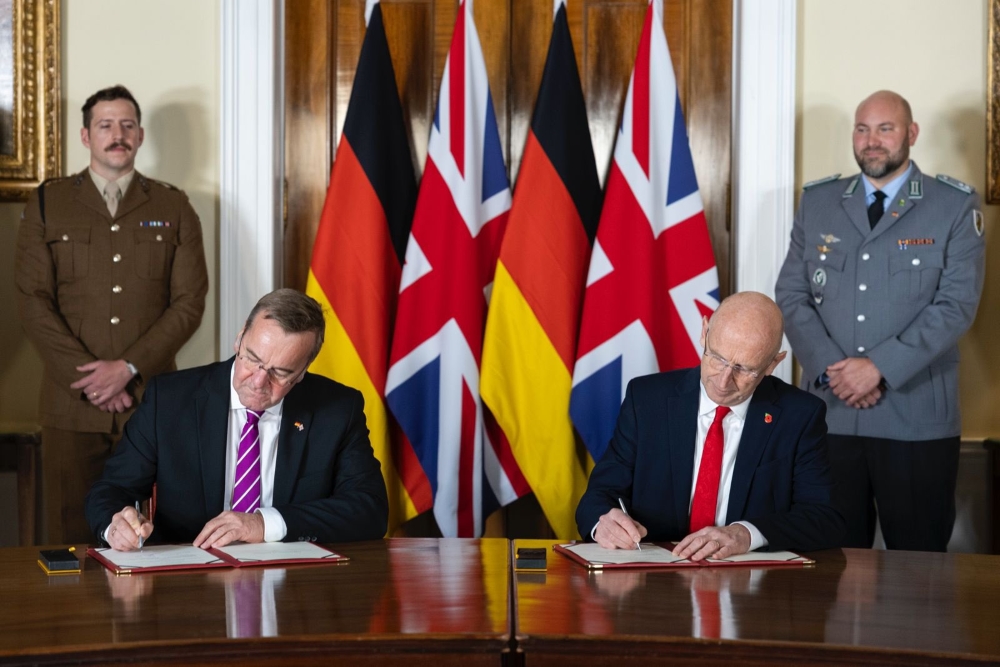
On Wednesday 23 October, the Defence Ministers of UK and Germany have signed the Trinity House Agreement which enhances bilateral defence co-operation between the two Countries.
For the new UK Labour government, the new Deal with Germany was an early objective meant to signal a purported rekindling of relationships following Brexit. The Labour narrative is questionable at best, since UK and Germany already had several joint projects underway, established under the previous administration.
Those projects already in place included the training of a significant number of german helicopter pilots in the UK; the BOXER program; the joint procurement of new-build BvS10 Mk2 All Terrain Armoured Vehicles within the Collaborative All-Terrain Vehicle (CATV) programme (to be known as CENTAUR in UK service); the development of the new Ke2020Neo APFSDS anti-armour round for tanks; the BOXER RCH155 self-propelled howitzer and project TRITON for the joint procurement of replacement platforms for the M3 amphibious rigs that equip the joint 130 Engineer Battalion in Germany (which includes, since 2021, the 23 Amphibious Squadron of the Royal Engineers).
The UK had also already joined the German-led European Sky Shield Initiative while setting up its own Delivering Integrated Air and Missile Operational Networked Defences (DIAMOND) initiative under NATO to ensure successful integration and interoperability of the various relevant systems in service across the Alliance.
These projects continue and are in some cases “re-announced” by the new Government, which also adds a further element of cooperation presumably descending from the Ammunition Strategy that had been launched under the previous administration: the regeneration of a sovereign, UK-based capability to produce artillery barrels.
As previously announced, Sheffield Forgemasters will supply the necessary special steel, and it is now specified that a factory for gun barrels will be set up by Rheinmetall in the UK, supporting the CHALLENGER 3 (120 mm smoothbore L55A1) and RCH 155 (155/52 mm howitzer) projects.
In terms of genuinely new commitments, the UK has elected to join the European Long Range Strike Approach to “develop common requirements” and, in the medium term, to “deploy extended Deep Precision Strike (missile capabilities) in all physical domains”.
Most interesting is the cooperation on drones, where the intent to work cooperatively on cross-system Combat Cloud(s) and “common offboard systems” signals the possibility, if not yet the intent, of making the respective future 6th gen Fighter Jets able to “share” the uncrewed wingmen and adjunct platforms of the future, with interoperable networks and with possibly common drones.
The agreement also includes “joint exploration and development of new Maritime Uncrewed Air System capabilities” which, while not better specified, sounds likely to revolve around the 3-ton PROTEUS demonstator uncrewed helicopter being built by Leonardo UK ahead of trials expected new year. The deal also references “joint integration of common missile systems into drone fleets”, specifically mentioning BRIMSTONE: with Germany adopting the missile for its TYPHOON fleet and the UK already integrating it also on MQ-9B, it seems safe to assume Berlin is now looking at putting the weapon on the EuroMALE too, when mature.
At sea, efforts in the North Atlantic and in the protection of critical undersea infrastructure will be closely coordinated. Under the previous UK government, a refreshed deal had already been concluded to renew german access to FOST operational sea training in UK waters.
Episodic deployments of German P-8A Poseidon Maritime Patrol Aircraft to RAF Lossiemouth, home of the RAF’s own P-8s, are envisaged along with joint development of a common training solution for the type. Considering the RAF side is already well established, it is probable german crews will train in the UK at 42 Sqn, the OCU for the type.
The deal also contains provision to “promote” a “common co-operative procurement of the UK’s Lightweight Torpedo STINGRAY MOD 2” for the respective P-8 fleets. Germany is faced with the choice of continuing to use American MK54 torpedoes on its P-8; seek integration of MU90 torpedoes on the type or cooperate with the UK on STINGRAY, which the UK is already integrating and which could gain Norway’s interest too (as a STRINGRAY Mod 1 user). In the medium term, the countries will “explore” cooperative development of novel offboard undersea surveillance capabilities (underwater drones).
Interestingly, the UK will assist Germany in fitting “modern missile systems” to ex-German Navy SEA KING helicopters to be supplied to Ukraine. We assume it probably means LMM MARTLET missiles, most likely as an air to air, drone-chasing solution as other options are not immediately obvious.
On land, cooperation is looking at adjunct Uncrewed Ground Vehicles to support crewed armour, and greater coordination, including with Canada and the Baltic States, to “rapidly transform the capability and effectiveness of our respective Forward Land Forces” in the Baltic.
The German-Dutch Corps HQ is to take responsibility for the area under the new NATO Defence Plans, while the UK’s ARRC is to transition to the role of Strategic Reserve for SACEUR (along with France’s own Corps). Coordination here was always going to be imperative.








.png)
